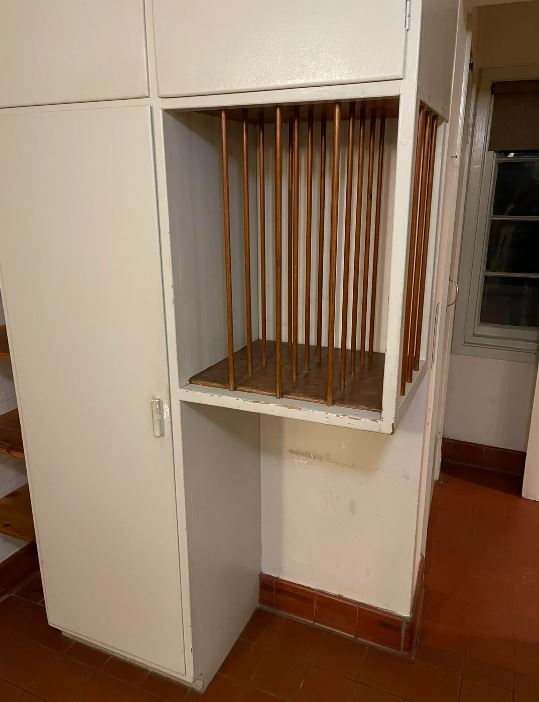In the heart of the English Midlands, a curious kitchen artifact recently surfaced, captivating online communities with its strange appearance and mysterious purpose. Discovered by a user on Reddit, the item appears at first glance to be an ordinary wooden object, but a closer look reveals that it’s anything but.

This piece of carved wood, equipped with a series of flexible pegs or dowels that can be adjusted or moved, clearly had a functional purpose in the kitchens of the past. Its unique design sparked widespread interest, especially among history enthusiasts and culinary experts, who immediately began speculating about its origins and intended use. While it may seem simple, this object offers a glimpse into the everyday life and domestic practices of a time long gone.
The fact that it was found prominently placed in a kitchen suggests that it once played a regular role in food preparation or perhaps served a very specific culinary function that has since faded from modern practice. The adjustable pegs imply that it may have been used to hold various kitchen tools or utensils in place, or possibly to support ingredients during preparation. Some believe it could have even played a role in early baking techniques, perhaps for drying or shaping dough, though no one can say for sure without further investigation. The mystery surrounding this artifact only deepens when one considers the lack of similar items in contemporary kitchens, pointing to a highly specialized, now obsolete function.
To truly understand the significance of this kitchen relic, one would need to delve into historical archives, consult local historians familiar with regional cooking practices, or perhaps visit museums dedicated to domestic life in the Midlands. These institutions often house collections of antique kitchenware and may hold clues or documentation about items like this. Through these resources, researchers might trace the artifact’s usage, materials, and construction techniques, potentially revealing more about the daily routines of the families who once relied on it. Beyond its practical use, the item also carries cultural weight, serving as a symbol of how domestic life has evolved.
It offers a tangible link between generations, reminding us of the ingenuity and resourcefulness of those who cooked with far fewer tools than we have today. In that sense, the artifact becomes more than just an old kitchen tool—it transforms into a historical document, carved not from paper but from wood and craftsmanship. It’s fascinating to consider how such everyday items, overlooked in their time, can become focal points for storytelling and education when rediscovered decades or centuries later. Holding this object is like shaking hands with the past, feeling the texture of history through its smooth wood and moveable components. Its very existence in a modern setting bridges a gap between contemporary life and ancestral customs. Each peg, each groove, whispers stories of meals shared, traditions followed, and the rhythm of domestic life that once pulsed in the same kitchen where the item was found. In a world increasingly defined by disposable gadgets and fast-paced living, there’s something grounding about uncovering a relic that demanded patience, skill, and care. This mysterious kitchen tool prompts us to reflect on what we’ve gained and what we may have lost in the rush toward modernization. It challenges us to appreciate the unseen narratives embedded in the objects around us and to remain curious about the roles they once played. More than just a talking point on Reddit, this relic serves as a humble but profound reminder that history lives in the quiet corners of our homes, waiting to be discovered and shared. Whether its true identity is ever confirmed, the artifact has already succeeded in connecting people across time, space, and the internet, proving that even the smallest of items can inspire big questions about who we are and where we come from.





